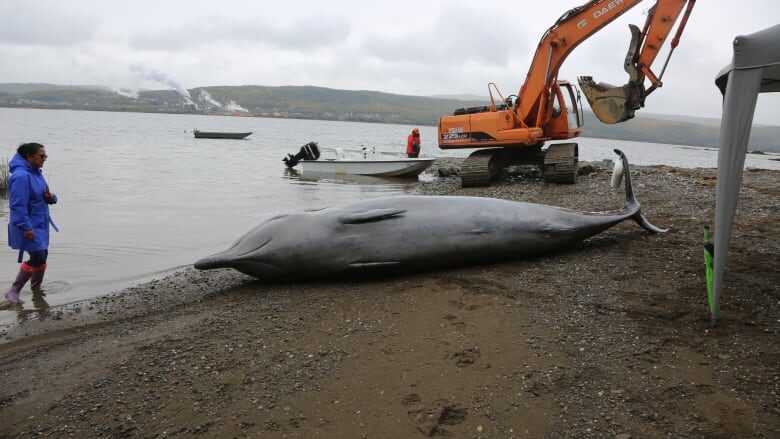
A report that the whales were stranded in shallow water came to the Marine Animal Response Society on Sept. 30.
"At that time, the report was that local people — and I think it was actually local police — had pushed these two animals back in the water, and so then they swam off," said Tonya Wimmer, executive director of the Marine Animal Response Society.
After being pushed back into the deeper water, the whales were stranded again later that night. One of the whales died, Wimmer said they believe the other swam free.
Images of the whales were sent to Wimmer and MARS in Halifax.
"The first thing we noted was that these animals were nothing we had really dealt with in that region before."
Northern bottlenose whales can sometimes be found off the coast of Sable Island, and off the coast of Newfoundland and Labrador in the Davis Strait, but they don't usually venture any closer to the Maritimes. They are considered a species - at - risk.
"We do have situations where animals sort of wander around or wander off," said Wimmer. "This is a bit of an extreme for this species."
The whales prefer deep water as they dive more than 1,000 metres deep. Why they were in Chaleur Bay is puzzling, said Wimmer.
"That's really the question that we've all been asking ourselves over the last few days since this incident happened."
"We definitely have had bottlenose whales that have found their way into sort of the Atlantic coast side of Nova Scotia or even along the Atlantic coast of Newfoundland at times, but not really into the northern part of the Gulf of St. Lawrence. So it definitely raised a lot of questions for us in terms of why these animals would be here to begin with."

"As I'm sure you're aware, they're not really supposed to be in the Gulf (of St. Lawrence), which is a fairly shallow area, and certainly not in the Bay of Chaleur."
Bourque is a wildlife pathologist with Canadian Wildlife Health Cooperative at the Atlantic Veterinary College. She described the whales as an "enigmatic" species.
"They're deep divers, and they're usually out on the Scotian Shelf. And so they don't hang around where people can see them. There's not a lot that is known about their biology, their ecology, all of that. So they're a bit mysterious."
Bourque performed a necropsy on the dead whale the next day.
She said there were no apparent signs of trauma or fishing entanglements or chronic infectious disease.
"I think it's probably going to be a case of stranding by mishap, which is the term that we usually use to describe cases of animals that are adapted to be living in very specific coastal type environments that suddenly find themselves in very shallow and possibly muddy environments, where their echolocation, their ability to navigate in the water column is changed. So they're not very good at navigating in a different type of water column," she said.
Bourque said it's possible there was something in the whales' environment that could have pushed them out.
"Could be weather, could be something anthropogenic or manmade, large ships — very, very loud noises in the ocean might either startle them or make it so that they can't actually efficiently hear what's going on in their environment."
Bourque said it will be several weeks before the final necropsy report is ready.



Reader Comments
to our Newsletter